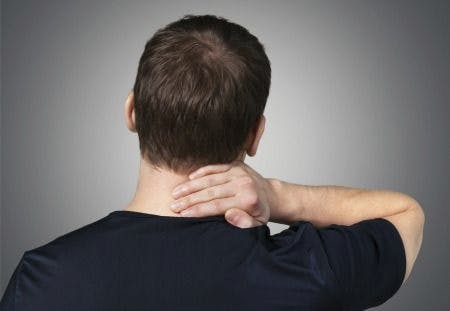What is a whiplash injury?
Whiplash is a neck injury when your head is thrown backwards (hyperextension) at a high speed and then thrown or bounced forward (hyperflexion) in a quick manner, or vice versa. These typically happen when a passenger is hit from the front or the back of the car; or when hit on the head from a contact sports injury. Ligaments, muscles and tendons are injured on a microscopic level in whiplash accidents, and in severe cases nerves and neck joints can be injured as well.
Physical Therapy whiplash treatment can be very helpful for recovery and pain control from whiplash accidents, and there are also several other healthcare professionals who can help tremendously in dealing with the trauma of a whiplash injury.
Signs and symptoms of whiplash injury
- Pain in neck and shoulders and/or upper back area.
- Weakness in your arms and hands
- Dizziness
- Headaches
- Loss of range of motion in the neck

First step after a car accident: See a physician.
Although most whiplash injuries have mild to moderate symptoms and may take anywhere from a day to a week to manifest, some severe cases warrant immediate physician attention. It is always best safe than sorry, and proper diagnostics is necessary to first rule out life-threatening injuries such as fractures, dislocations, or internal bleeding.
- Your physician will likely perform an X-ray of your cervical spine to rule out dangerous fractures or dislocations. An open-mouth X-ray is best to look at the bones from the back as well as from the back of the neck (called an open-mouth dens X-Ray).
- Your physician may order a soft neck collar for support of your neck. This may help temporarily to alleviate some pain and difficulty in holding your head up. The collar should only be used temporarily, though, as research has shown that wearing it for too long will cause muscles to weaken and atrophy, further prolonging the instability and pain in your neck.
- If you experience any of the following symptoms, it is important to contact your physician right away: any loss of consciousness, profound loss of sensation in arms, legs or torso.
- An orthopedist, neurologist or specialist may conduct further tests if they feel your neck is not stable. These may come in the form of CT or MRI scans. They will likely be checking for spinal cord damage, herniated disks or torn ligaments.
In some cases, a physician's referral may be necessary for certain insurance plans so it is good to take this first step of clearance from a physician so initiating physical therapy for whiplash treatment will be trouble-free.

How to Control Pain and Inflammation at home
Pain regulation is very often in healing – controlling for pain will allow your muscles to relax, circulation to improve, and help your sleep longer and better for healing. Consult with your physician your best route of oral painkillers. Anti-inflammatories (NSAIDs) or stronger prescriptions like oxycodone may be prescribed.
Though pain control is necessary in the first stages of healing, it is important to remember that these medications may be hard on your stomach, kidneys and liver; and in some cases may be addictive, or try not to extend continual use of them for longer than 2 weeks.
In the first 2 weeks after the accident, cold therapy can be used for effective pain relief and inflammation control. A cold pack can be applied directly to the head in the case of the headache. It cold pack can also be applied directly to the neck, though some patients cannot tolerate this for very long. Typical cold treatments should be kept for 15 min stretches, several times a day as needed for pain. Make sure a cloth barrier separates the cold pack from the skin to prevent frostbite – we like to use pillow cases at our clinic.
Physical Therapy for Whiplash
It is important to start physical therapy as soon as you can after the accident, or when your physician deems you ready for this type of whiplash treatment. Patients who begin gentle movement and exercise in the form of proper stretches and exercises have better prognoses than patients who choose to wait to schedule. Don't worry – your physical therapist will still be able to look for warning signs of major instability in case some steps mentioned above at the physician's office were skipped. Your physical therapist will assess range of motion, strength, pain level, soft tissue tightness and nerve function and formulate a plan of care that involves tailored stretches and stability exercises to promote healing.
Following is a general plan of care of what a physical therapist might do for you if you've experienced a whiplash injury:
- Manual therapy and gentle mobilization of muscles and joints: Injured muscles and tendons quickly tighten and spasm, so gentle manual therapy can help reduce this. Additionally, any muscle tears on a microscopic level can benefit from improved stimulation and circulation brought by soft tissue mobilization. Gentle joint mobilizations can help loosen locked-up joints that cause pain and stiffness.
- Stretching and/or movement exercises: Stretching exercises can help with gaining back flexibility in your neck and prevents cervical joints from getting too stiff. Stretches should be kept easy and tolerable, with gentle pulls towards end range of motion. It is important to not induce pain during these stretches and movements, because this means that you are irritating the injured muscle, joints and ligaments.
- Stability and Strengthening exercises: When the neck pain is alleviated a little, strengthening exercises can help regain stability in the neck so keeping the head up for work, and daily living can be become easier and pain-free. Strengthening treatments typically start with isometric exercises – which involve pushing the neck or head against a gentle resistance that does not move. It is vital to start deep neck flexor strengthening exercises – the deep neck flexor muscles are considered the "abdominals" of the cervical spine and offers the most helpful stability to the neck.
- Establishment of a Home Exercise Program: Because most patients do not have the luxury of seeing their physical therapist every day, establishment of a set of safe, home exercises for patients to do on their own is necessary to keep the momentum of healing going between visits.
- Resistive Exercises for Shoulders & Arms: Strengthening the arms, shoulders and upper back is necessary and healthy for posture. It is likely that your posture has suffered ever since the injury and this is due to a combination of pain and deconditioning of muscles. Once your neck pain is healing to a good level, resistive exercise for the upper extremities and the upper back would allow you to return to work, daily activities, and sports healthily and prevent recurrence of neck symptoms.
- Vestibular Rehab for Dizziness: studies show that vestibular rehabilitaion can have a very successful impact on dizziness after a whiplash car accident. Our physical therapists will evaluate and asses your vestibular system and through a combination of manual and exercise therapy, help you through your dizziness symptoms. (Resource: https://www.ncbi.nlm.nih.gov/pubmed/31469527)
Your physical therapist may choose to use additional methods of whiplash treatment to achieve pain control. In the clinic he/she may choose to use TENS machines or traction units to help modulate the pain. TENS units provide a vibratory sensation to the painful and tight muscles that compete with pain signals to the brain, thereby reducing painful feelings non-narcotically. Cervical traction units provide a gentle upwards pulling on your neck that also helps with blood flow and stretch in muscle and inside joints.

Adjunct Healthcare
Consider acupuncture. Acupuncture involves sticking thin needles to specific energy channel points and meridian part of the body that could potentially aid in stimulating healing. Acupuncture is not able to heal patients from whiplash injuries on its own, and should be considered as a secondary adjunct option to physical therapy. For this type of whiplash treatment, consult with your PT for trusted acupuncturists near you.
Consider seeing a concussion therapist, or a mental health counselor. If your whiplash injury is the result of a car accident, there are often far-reaching psychological effects of the accident. Patients may feel panicky and trepid to sit behind the wheel. Talk therapy can help patients in overcoming anxiety and fear. Additionally, if confusion and memory loss is one of your symptoms – which is very likely in head injuries, a concussion therapist may help in regaining this function.
Consider other lifestyle changes: 1) Avoid carrying heavy bags (>5-8lbs) that place excessive pressure and strain on neck and shoulder muscles. 2) Practice better posture at work and while doing daily activities. Working on posture allows you to continually strengthen stability exercises of the neck and helps maintain good habits for even after your injury. 3) Smoking impairs blood oxygenation and blood flow. Abstaining from smoking while healing will ensure your body receives the best nutrients during this interim.
If you are experiencing symptoms of whiplash then please contact us immediately for pain relief.
Same-day/Next-Day Appointments are Available.
Check out our location nearest you and give us a call at to Get Started!

